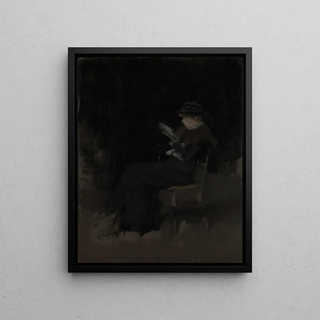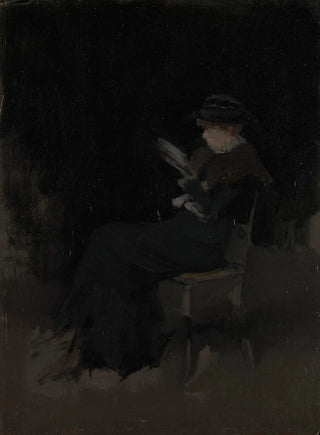Art print | Arrangement in Black Girl Reading - James Abbott McNeill Whistler


View from behind

Frame (optional)
Arrangement in Black Girl Reading - James Abbott McNeill Whistler – Captivating Introduction
The artwork "Arrangement in Black Girl Reading" by James Abbott McNeill Whistler embodies a striking encounter between the art world and everyday life. Painted at the end of the 19th century, this canvas depicts a young woman engrossed in her reading, a frozen moment where time seems to stand still. The composition, both intimate and universal, invites the viewer to contemplate not only the subject but also the emotions and thoughts that inhabit her. The dark color palette, dominated by black and blue, evokes an atmosphere of serenity and reflection, while the posture of the central figure suggests a deep connection with the text she is exploring. This piece, beyond its apparent simplicity, is an invitation to delve into the inner universe of its character.
Style and uniqueness of the work
Whistler stands out for his unique approach to painting. In "Arrangement in Black Girl Reading," he uses the term "arrangement" to emphasize the importance of composition and visual harmony within the artwork. Every element, from the furniture to the diffuse light, contributes to creating a balanced and thoughtful atmosphere. The female figure, dressed in black, seems to merge with the environment, thus reinforcing the idea that art is not limited to representation but extends to sensory experience. The artist skillfully plays with shadows and lights, revealing delicate nuances that highlight the scene's depth. This stylistic choice, characteristic of the tonalism movement, invites silent contemplation, where emotion takes precedence over explicit narration. Whistler's delicate touch and keen sense of harmony make this piece a masterpiece that transcends eras.
The artist and his influence
James Abbott McNeill Whistler, an emblematic figure of the Impressionist movement, managed to leave his mark through his innovations and artistic vision. Born in 1834, he led a rich and complex career, oscillating between experimentation and the pursuit of pure beauty. Whistler was often ahead of his time, challenging established conventions and advocating the idea that art should be a personal expression rather than a simple

Matte finish

View from behind

Frame (optional)
Arrangement in Black Girl Reading - James Abbott McNeill Whistler – Captivating Introduction
The artwork "Arrangement in Black Girl Reading" by James Abbott McNeill Whistler embodies a striking encounter between the art world and everyday life. Painted at the end of the 19th century, this canvas depicts a young woman engrossed in her reading, a frozen moment where time seems to stand still. The composition, both intimate and universal, invites the viewer to contemplate not only the subject but also the emotions and thoughts that inhabit her. The dark color palette, dominated by black and blue, evokes an atmosphere of serenity and reflection, while the posture of the central figure suggests a deep connection with the text she is exploring. This piece, beyond its apparent simplicity, is an invitation to delve into the inner universe of its character.
Style and uniqueness of the work
Whistler stands out for his unique approach to painting. In "Arrangement in Black Girl Reading," he uses the term "arrangement" to emphasize the importance of composition and visual harmony within the artwork. Every element, from the furniture to the diffuse light, contributes to creating a balanced and thoughtful atmosphere. The female figure, dressed in black, seems to merge with the environment, thus reinforcing the idea that art is not limited to representation but extends to sensory experience. The artist skillfully plays with shadows and lights, revealing delicate nuances that highlight the scene's depth. This stylistic choice, characteristic of the tonalism movement, invites silent contemplation, where emotion takes precedence over explicit narration. Whistler's delicate touch and keen sense of harmony make this piece a masterpiece that transcends eras.
The artist and his influence
James Abbott McNeill Whistler, an emblematic figure of the Impressionist movement, managed to leave his mark through his innovations and artistic vision. Born in 1834, he led a rich and complex career, oscillating between experimentation and the pursuit of pure beauty. Whistler was often ahead of his time, challenging established conventions and advocating the idea that art should be a personal expression rather than a simple






